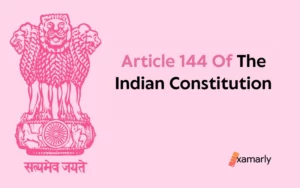Have you ever wondered what lies behind the smooth functioning of our nation? The Constitution of India serves as the backbone of our nation, guiding the formation and functioning of the Indian Union. Part 21 of the Indian Constitution delves into the intricacies of this crucial document, exploring the temporary, transitional, and special provisions that hold our nation together.
From the temporary nature of certain provisions to the special considerations for certain states, this part of the Constitution is a treasure trove of information for those seeking to understand the inner workings of our nation. So come, and join us on a journey as we uncover the secrets of Part XXI and discover the true power of the Constitution of India.
The knowledge that is provided in this article will be beneficial for the portion of the Civil Services Examination that is devoted to Polity.
- Part 21 Of The Indian Constitution
- Conclusion
- FAQs On Part 21
- Which Part Of The Indian Constitution Deals With Special Provisions That Apply To Certain States?
- Which Part Of The Constitution Of India Is Titled As Temporary Transitional And Special Provisions?
- How Many States In Which The Provisions Of Article 371 Is Applicable?
- What Is Article 371A Of The Indian Constitution?
- Who Drafted Article 370?
- Is Article 370 Permanent Or Temporary?
- Which Constitutional Amendment Has Amended Part XXI Of The Indian Constitution?
- How Many States Are Covered Under Articles 371 To 371-J?
Part 21 Of The Indian Constitution
The laws relating to the union of states that make up India as a nation and a country are collected in Part 21 of the Indian Constitution. The articles on temporary, transitional, and special provisions make up this part of the constitution. Article 369 to Article 392 are all covered under this Part of this Constitution.
Article 369
Article 369 gives Parliament the temporary power to create laws relating to some State List issues as if they were Concurrent List issues.
Check out the linked Article to learn more about Article 369 of the Indian Constitution.
Articles 370 – 371J
Special provisions for twelve states are contained in Articles 371 to 371-J of Part XXI of the Indian Constitution:
- Maharashtra
- Andhra Pradesh
- Telangana
- Sikkim
- Mizoram
- Arunachal Pradesh
- Gujarat
- Nagaland
- Assam
- Manipur
- Goa
- Karnataka
To meet the desires of the individuals who live in underdeveloped areas of the states; to safeguard the cultural and economic interests of the tribal people who live in those states; to address the law and order situation that exists in some portions of those states; to safeguard the interests of the local people who live in those states; or to do all of the above. These goals are the driving force behind these initiatives.
The constitution did not initially include any specific provisions for these states. They became a part of the constitution as a result of the numerous changes that were passed subsequently in the course of the reorganization of the states or the bestowing of statehood on the Union Territories.
- Article 370 – One of the most well-known of these temporary provisions is enshrined in Article 370 of the constitution of India, which pertained to the special status of the State of Jammu and Kashmir. However, it was revoked in 2019.
- Another provision, Article 371, applies to the States of Maharashtra and Gujarat, providing special provisions for the regions of Vidarbha and Marathwada in Maharashtra, and Saurashtra and Kutch in Gujarat.
- Article 371A – special provisions for the State of Nagaland, particularly for the Naga Hills and Tuensang area are covered in this Article.
- Article 371B and 371C provide special provisions for the administration of Bodoland Territorial Area and Manipur respectively.
- Article 371 D – Special provisions with respect to the State of Andhra Pradesh. By virtue of the Andhra Pradesh Reorganisation Act of 2014, the provisions of said Article were made applicable to the state of Telangana in 2014.
- Article 371E – It deals with the establishment of a Central University in the State of Andhra Pradesh.
- Article 371F provides special provisions for the state of Sikkim. Sikkim became a fully-fledged member state of the Indian Union in 1975 as a result of the enactment of the 36th Constitutional Amendment Act. The said amendment added Article 371F.
- Article 371G – special provisions for the state of Mizoram are provided under this Article.
- Article 371H – It outlines a special provision (law and order) for the State of Arunachal Pradesh.
- Article 371I – It outlines a special provision for the State of Goa (Portuguese culture). It specifies that there must be at least 30 members in the Goa Legislative Assembly.
- Article 371J – Special provisions for the State of Karnataka are outlined in this Article.
These provisions can range from addressing the administration and governance of the state to preserving cultural heritage, these special provisions play important role in understanding the functioning and diversity of the Indian Union.
Articles 372 – 378 And Article 392
The following table outlines Articles 372 to 378 and Article 392 and the provisions it deals with:
| S.No | Articles Of The Indian Constitution | It Deals With |
|---|---|---|
| 1 | Article 372 | Continuance in force of existing laws and their adaptation |
| 2 | Article 372-A | Power of the President to adapt laws |
| 3 | Article 373 | Power of the President to make orders in respect of persons under preventive detention in certain cases |
| 4 | Article 374 | Provisions as to Judges of the Federal Court and proceedings pending in the Federal Court or before His Majesty in Council |
| 5 | Article 375 | Courts, authorities and officers to continue to function subject to the provisions of the Constitution. |
| 6 | Article 376 | Provisions as to Judges of High Courts |
| 7 | Article 377 | Provisions as to Comptroller and Auditor-General of India |
| 8 | Article 378 | Provisions as to Public Service Commissions. |
| 9 | Article 378A | Special provision as to the duration of Andhra Pradesh Legislative Assembly |
| 10 | Article 390 | Power of the President to remove difficulties |
Articles 379 To 391: Omitted
Article 379 to Article 391 are all omitted from the Constitution of India which are presented below in a tabular form:
| S.No. | Articles Of The Indian Constitution | It Deals With | Omitted by |
|---|---|---|---|
| 1 | Article 379 | Provision as to provisional Parliament and the Speaker and Deputy Speaker thereof | Seventh Amendment Of The Indian Constitution |
| 2 | Article 380 | Provision as to President | Seventh Amendment Of The Indian Constitution |
| 3 | Article 381 | Council of Ministers of the President | Seventh Amendment Of The Indian Constitution |
| 4 | Article 382 | Provision as to provisional Legislatures for States in Part A of the First Schedule | Seventh Amendment Of The Indian Constitution |
| 5 | Article 383 | Provision as to Governors of Provinces | Seventh Amendment Of The Indian Constitution |
| 6 | Article 384 | Council of Ministers of the Governors | Seventh Amendment Of The Indian Constitution |
| 7 | Article 385 | Provision as to provisional Legislatures in States in Part B of the First Schedule | Seventh Amendment Of The Indian Constitution |
| 8 | Article 386 | Council of Ministers for States in Part B of the First Schedule | Seventh Amendment Of The Indian Constitution |
| 9 | Article 387 | Special provision as to the determination of population for the purposes of certain elections | Constitution (Seventh Amendment) Act, 1956 |
| 10 | Article 388 | Provisions as to the filling of casual vacancies in the provisional Parliament and provisional Legislatures of the States | Constitution (Seventh Amendment) Act, 1956 |
| 11 | Article 389 | Provision as to Bills pending in the Dominion Legislatures and in the Legislatures of Provinces and Indian States | Constitution (Seventh Amendment) Act, 1956 |
| 12 | Article 390 | Money received or raised or expenditure incurred between the commencement of the Constitution and the 31st day of March, 1950 | Constitution (Seventh Amendment) Act, 1956 |
| 13 | Article 391 | Power of the President to amend the First and Fourth Schedules in certain contingencies | Constitution (Seventh Amendment) Act, 195 |
Conclusion
The Constitution of India is the supreme law of the country, and its various parts and sections outline the fundamental principles and guidelines that govern the functioning of the Indian government and society. Among the many important provisions contained within the Constitution, Part XXI, which deals with “Temporary, Transitional and Special Provisions,” holds a special significance.
In the interest of further readings:
| 6th Schedule Of The Indian Constitution | Details Of Schedules Of The Indian Constitution |
| Part 22 Of The Indian Constitution: A Closer Look | Article 277 Of The Indian Constitution |
FAQs On Part 21
Which Part Of The Indian Constitution Deals With Special Provisions That Apply To Certain States?
Part XXI of the Indian Constitution contains a set of special provisions that apply to certain states. These provisions are designed to address the unique needs and circumstances of those states, and they serve as a means of ensuring that the Constitution takes into account the diversity of India’s regions.
Which Part Of The Constitution Of India Is Titled As Temporary Transitional And Special Provisions?
Part XXI of the Constitution of India is an important part of the supreme law of the country, containing temporary, transitional and special provisions that were put in place to address specific issues and challenges facing the nation during its early years of independence.
How Many States In Which The Provisions Of Article 371 Is Applicable?
There are 2 states in which Constitutional provisions of Article 371 are applicable. These 2 states of India are Maharastra and Gujarat.
What Is Article 371A Of The Indian Constitution?
Special provisions are outlined in Article 371A for the State of Nagaland, namely for the Naga Hills and Tuensang region.
Who Drafted Article 370?
The main drafter of Article 370 of the Indian Constitution, which gave the state of Jammu and Kashmir local autonomy, was Ayyangar.
Is Article 370 Permanent Or Temporary?
Article 370 of the Constitution of India is described as a “temporary provision” that grants the state of Jammu and Kashmir a special autonomous status within the Indian union.
Which Constitutional Amendment Has Amended Part XXI Of The Indian Constitution?
The 13th amendment of the Indian Constitution substituted the title “Temporary, Transitional And Special Provisions” in the thirteenth year of the Indian Republic.
How Many States Are Covered Under Articles 371 To 371-J?
12 States are covered by special provisions in Articles 371 to 371-J of Part XXI of the Constitution. The purpose of these provisions is to address the needs of the residents of underdeveloped areas of the states, to safeguard the cultural and economic interests of the tribes living in the states, to deal with the erratic law and order situation in some areas of the states, or to advance the local population’s interests. The original constitution did not include these constitutions. They were added in after the fact through a number of different revisions.






